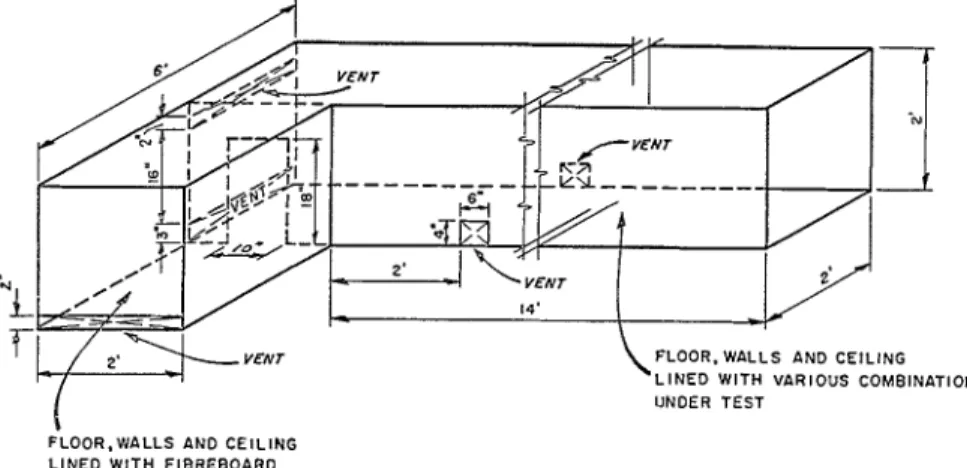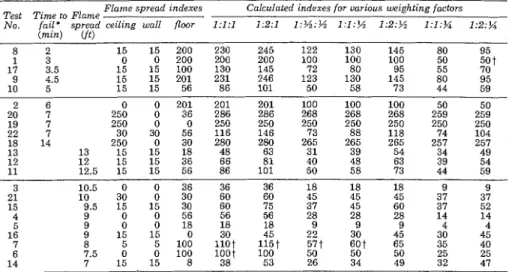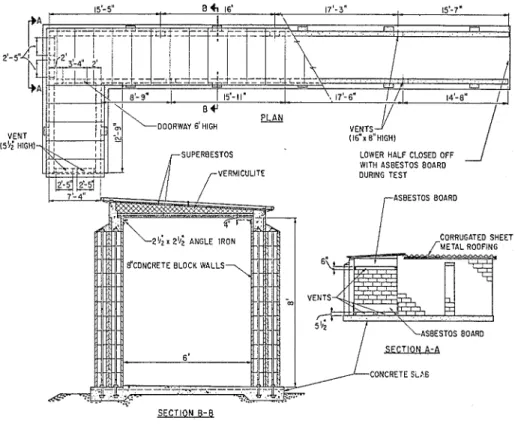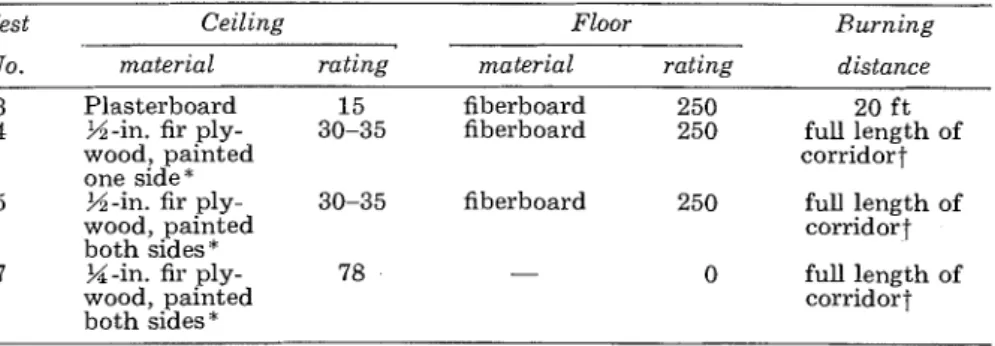Publisher’s version / Version de l'éditeur:
Vous avez des questions? Nous pouvons vous aider. Pour communiquer directement avec un auteur, consultez la
première page de la revue dans laquelle son article a été publié afin de trouver ses coordonnées. Si vous n’arrivez pas à les repérer, communiquez avec nous à PublicationsArchive-ArchivesPublications@nrc-cnrc.gc.ca.
Questions? Contact the NRC Publications Archive team at
PublicationsArchive-ArchivesPublications@nrc-cnrc.gc.ca. If you wish to email the authors directly, please see the first page of the publication for their contact information.
https://publications-cnrc.canada.ca/fra/droits
L’accès à ce site Web et l’utilisation de son contenu sont assujettis aux conditions présentées dans le site LISEZ CES CONDITIONS ATTENTIVEMENT AVANT D’UTILISER CE SITE WEB.
Research Paper (National Research Council of Canada. Division of Building
Research); no. DBR-RP-365, 1968-05-01
READ THESE TERMS AND CONDITIONS CAREFULLY BEFORE USING THIS WEBSITE.
https://nrc-publications.canada.ca/eng/copyright
NRC Publications Archive Record / Notice des Archives des publications du CNRC : https://nrc-publications.canada.ca/eng/view/object/?id=f32de00d-4d7e-4caf-8f3a-4bae5b4401b7 https://publications-cnrc.canada.ca/fra/voir/objet/?id=f32de00d-4d7e-4caf-8f3a-4bae5b4401b7
NRC Publications Archive
Archives des publications du CNRC
This publication could be one of several versions: author’s original, accepted manuscript or the publisher’s version. / La version de cette publication peut être l’une des suivantes : la version prépublication de l’auteur, la version acceptée du manuscrit ou la version de l’éditeur.
For the publisher’s version, please access the DOI link below./ Pour consulter la version de l’éditeur, utilisez le lien DOI ci-dessous.
https://doi.org/10.4224/40001492
Access and use of this website and the material on it are subject to the Terms and Conditions set forth at
Spread of fire in corridors
McGuire, J. H.
Ser
365
NATIONAL RESEARCH COUNCIL OF CANADAc . 2
JONSEIL NATIONAL DE RECHERCHES
DU
CANADABLDG
The Spread of Fire in Corridors
by
J .
H. McGuireReprinted from Fire Technology Vol. 4, No. 2, May 1968
pp. 103-108
Research Paper No. 365 of the
Division of Building Research
OTTAWA May 1968
Price 10 cents NRC 10116
LA PROPAGATION DU FEU DANS LES CORRIDORS
SOMMAIRE
L'auteur dQcrit l'incendie de moditles d'ensembles corridor et p2ce reproduits h lJQchelle du quart ou grandeur nature. Les rev2tements de plancher des ensembles en grandeur naturelle n'ont jouQ qu'un r61e minime dans la propagation du feu. L'incendie ne s'est pas propagQ jusqu'h l'extrQmitQ du corridor quand le plancher et les murs Qtaient incom- bustibles et que le plafond Qtait garni d'un revetement dont la cote de propagation des flammes Qtait infhrieure a 130. D'autre part, les ensembles oh le revetement des murs avait une cote de 35 et oh les autres QlQments 6taient incombus- tibles ont 6th bri?lQs complittement. Les revetements de plancher du moditle h 1'Qchelle du quart ont fortement contribuQ h la propagation de l'incendie.
I
REPRINTED FROMF I R E TECHNOLOGY
I
I
Vol. 4 No. 2 M A Y 19681
The
Spread of Fire in Corridors
J.
H.
McGUIRE,SFPE
Division of Building Research National Research Council, Canada
Full- and quarter-scale experimental fires in corridor-room as- semblies, using various combinations of floor, wall, and ceiling lin- ing materials, yielded some interesting results. Between the small- and large-scale tests, there were marked differences in the relative effects of floor coverings and ceiling linings.
ESTS to determine comparative ratings of the flame spread character-
Tistics of materials have existed for a t least 20 years. Although the
test results do not agree completely and the validity of many of the tests is questionable, the principal area in which further information is immediately required concerns how to make use of the ratings in choosing wall and ceiling linings and floor coverings when a building is being designed.
T h e average room, hall, or other compartment in a building contains enough combustible material to allow a fire to develop fully. T h e nature of the building lining materials and contents will influence the likelihood of such a fire and the time i t will take to develop. T h e relationship is so complex, however, t h a t no analysis capable of universal application has yet been derived.
T h e corridor differs from most compartments in that i t may have few combustibles in it; i t can, therefore, be designed so t h a t i t will not of itself sustain or propagate a fire. An investigation was initiated to determine the limiting combinations of ceiling, wall, and floor lining materials t h a t would
propagate fire indefinitely. It was postulated t h a t floors, walls, and ceil-
ings in the corridor would perform in the sequence given by Method of
Test of Surface Burning Characteristics of Building Materials, N F P A
No. 255 (also UL 723 and ASTM E84), and by Standard Method of Test
for Surface Flammability of Materials Using a Radiant H e a t Energy Source, ASTM E162. Initially, it was assumed t h a t these tests have identical scales.
S M A L L - S C A L E T E S T S
T o expedite results and reduce costs, the first series of experiments was carried out on a small scale. Scaling experimental burns is usually impos-
NOTE: This paper is a contribution from the Division of Building Research, Na- tional Research Council of Canada and is published with the approval of the Director of the Division.
Copyright 1968 NATIONAL FIRE PROTECTION ASSOCIATION Printed i n U.S.A. 6 0 BATTERYMARCH ST., BOSTON, MASS. 02110
10-1 Fire Technology
sible because of illcompatibility among the scaling requirements of the many variables involved. I t was hoped that scaling would prove valid in the corridor program, however, because radiation was considered to be a n all-important factor.
Figure 1 illustrates the quarter-scale model. The component materials
were angle iron and X-in. asbestos board, none of the angle iron being
directly exposed to fire.
A
substantial fire in the room was intended tocreate severe exposure a t one end of the corridor only. For each test, the entire model room was lined with fiber insulation board and the fire was initiated with 50 cc of gasoline. Flames issuing through the doorway from the room did not extend far down the model corridor, as the high level vent a t the end of the corridor largely directed them t o the exterior. The other
vents and inlets illustrated in Figure 1 were chosen to make conditions
favorable to the propagation of fire along the corridor.
,FLOOR. WALLS AND CEILING
L I N E D WITH VARIOUS COMBINATIONS UNDER TEST
FLOOR.VIALLS AND CEILING LINED WITH FIBREBOARD
Figure 1. Small-scale test assembly.
Twenty-two tests were carried out, and the results are given in Table 1.
I n each case, a body of flame occupying the whole cross-sectional area from floor to ceiling either spread rapidly to the end or died out. T o make the
results more meaningful, the seven right-hand columns of Table 1 were
calculated to give composite indexes relating to the overall flammability or flame-spread properties of the assembly. Such calculations, using simple
weighting factors, assume the laws of linear addition to be applicable - a
sweeping assumption.
The composite indexes for tests 10 and 11 (underlined) are of particular
interest because the same borderline combination of materials was used for each, and in one case fire propagated to the end, and in the other it did not.
Taking these values as thresholds, the composite indexes of columns 11
and 12 prove to be compatible within themselves. For the tests where fire propagated to the end, the indexes are higher than the threshold value, and vice-versa. If the flame-spread indexes of the ceiling, wall and floor
Corritlors
TABLE 1. Small-scale Corridor Test Results
Flame spread indexes Calculated indexes for various weighting factors
Test Time LO Flame
No. fail* spread ceiling wall floor 1 : I : I 1 : 2 : 1 I : % : % I : I : % 1:2:% 1 : l : M 1 : 2 : M
( m i n ) ( f t l
-.
*i.e. time for fire to involve flooring 18 in. from end. t ~ d u l d contradict criterion underlined.
lining materials are designated by C, W, and F , respectively, the small- scale work can be summarized by saying that the criteria governing whether fire propagated to the end of the model corridor was of the nature
of‘^
+
2W+
F/2<
75 or C+
W+
F / 4<
45.L A R G E - S C A L E W O R K
Persons with practical experience of fire in buildings considered the significance of floor covering materials in propagating fire in the small- scale corridor to be much greater than would be expected on a large scale. Linoleum, for example, with a flame spread rating of about 200, has been a fairly common floor covering material, but has not acquired a reputation for contributing substantially to rapid spread of fire. The assembly il- lustrated in Figure 2 was constructed to permit a full-scale investigation of this feature. Ventilation arrangements were based on the same con- siderations as in the small-scale tests, and, t o develop a substantial fire in
the room, the ceiling was lined with fiber insulation board and nine sheets (4 f t by 8 ft) were stacked vertically (the 4-ft dimension being vertical), resting on pieces of 2-in. by 2-in. lumber 10 in. off the floor.
For the first 10 tests t h a t were carried out, ceiling "lining" materials were slid in place along angle iron runners 4 in. from the ceiling on the two interior walls of the corridor. Four interesting results, summarized in Table 2, indicate that the criterion applicable to the small-scale corridor did not apply to the large-scale one and that the significance of floors was much less.
The way in which the fire propagated was noticeably different. On the small scale, a body of flame occupied the whole cross-section of the cor-
106 Fire Technology
ridor, whereas on the large scale, the flame front associated with the floor could be differentiated from that associated with the ceiling although the two were interacting. In most cases, the flames were merging some dis- tance behind the flame front.
SECTION 8-8
Figure 2. Large-scale test assembly.
During several of the first ten tests, it became apparent that the method of installing the ceilings was substantially influencing results. Penetration of the cavity above the ceiling and early collapse of the ceiling panels were both promoting fire propagation. The method of installing ceilings was, therefore, changed. For subsequent tests, ceiling panels were bolted to %-in. asbestos board, which in turn was stiffened by 3 pieces of angle iron. The finished units were again slid into place on the angle iron runners.
The results of the more interesting of the next series of tests are sum- marized in Table 3. Test No. 12 suggests that the threshold rating a t
which a ceiling constitutes a severe hazard, in the absence of any other
combustible materials, exceeds 130. Test No. 14 indicates that floor lin- ings with a rating of less than 200 are not likely to have a substantial in- fluence on the spread of fire in a corridor.
Initially, it had not been intended to test materials with ratings greater than 200, but towards the end of the program a question arose as to whether highly flammable carpets constituted a hazard. Test No. 25 was
Corridors 107
conducted using a cellulose triacetate carpet with a rating of 435 and the result suggested that such flooring materials could contribute substantially to the propagation of fire and that, with a slightly flammable ceiling, fire would propagate indefinitely.
TABLE 2. Tests Involving False Ceilings
Test Ceiling - Floor R u r n i n e
-
N o . material rating material rating distance
3 Plasterboard 15 fiberboard 250 20 f t 4 W-in. fir ply- 30-35 fiberboard 250 full length of
wood, painted corridor?
one side*
5
W
-in. fir ply- 30-35 fiberboard 250 full length ofwood, painted corridor?
both sides*
7 %-in. fir ply- 78 - 0 full length of
wood, painted corridort
both sides*
* Fire retardant paint.
t
Largely because ceiling fell.The remaining results listed suggest that wall linings contribute sig- nificantly to fire hazard in a corridor. The last four results, concerning ceiling-wall combinations, are not compatible within themselves and indi- cate that the merit sequence established by the El62 test was not valid a t the extreme low end of the scale.
The upper portions of the walls of a corridor are probably more im- portant in propagating a fire than the lower, a feature that will be investi- gated in the next series of experiments.
S C A L E E F F E C T
The greater effect of floor coverings in the 2-ft compared with the 6- to 8-ft scale corridor is particularly interesting when related to work car- ried out a t Southwest Research Institute with the "tunnel" furnace.l Flame-spread tests were carried out with test specimens located on the floor of the apparatus instead of on the ceiling as is standard. Ten ma- terials, tested in the modified manner on the floor, gave an average index that was only 18 per cent lower than that given by standard tests. The interior vertical height of the tunnel furnace was 1 ft.
In experiments where the vertical dimensions have been (a) 8 ft,
(b) 2 f t and (c) 1 ft, the contribution of floor coverings to fire propagation, compared with ceiling linings, has been (a) very small, (b) about half to a quarter as important and (c) almost as important. All the experimental constructions had walls and had approximately square cross-sections (the tunnel furnace is 1 ft high by 18 in. wide); it would be interesting to learn whether the scale effect is influenced by horizontal dimension. Field experi- ence suggests that the scale effect does exist when the horizontal dimension is large in comparison with the height.
Fire Technology
TABLE 3. Selected T e s t Results
Ceiling Floor Wall
m . ~ . r o l i r ~ g
!55 mnlerial E l 6 2 moterial E16.tigo, 255 Burning distance
" P
12 X-in. tempered 130 - 0 - 0 4" I C
hardboard
14 %-in. fir plywood, 90 fiberboard 220 - 0
p a ~ n t e d both s ~ d e s * 20 f t
25 - 0 cellulose 435 - 0
triacetate 40 f t a n floor
carpet
19 - 0 - 0 %-in. fir plywood, 35 full length of
- 0 - painted bath sides* corridor
20 0 %:in. fir plywood, 27 12 f t
- pnlnted both sides'
21 %-in. fir plywood, 11 0 %:in. fir plywood 11- full length of
painted bothsides*
- painted both sides"
;;%
corridor22 %-in. plnsterbonrd 21 0 M-in. plaster- 20 i t
- board
23 %-in. fir plywood, 3 15 0 %-in. fir plywood, 3 15 8 i t
impregnatedt
- impregnatedt
24 746-in. fire retard- 8 35 0 %-in. fire retard- 8 35 full length of
a n t particle board a n t "article board corridor
' Fire retardant paint.
t Impregnnted w ~ t h a fire retardant.
1 T h e final 36 f t of wall lining was materinl from Test No. 20 with rating of 27.
A scale effect of this nature would reiiltroduce the importance of the
flammability of floor coverings in a slightly different context from t h a t dis- cussed so far. When located under furniture, a flammable floor covering would facilitate propagation to the boundary of the area involved. T h e scrim often found beneath an armchair, for example, can create a combina- tion that will propagate fire readily. I n cases such a s this the item of furniture can become fully involved in fire.
C O N C L U S I O N
Floor coverings with a rating of 220 and less made little contribution t o the indefinite propagation of fire along the large-scale test corridor. I n the small-scale model the significance of floor coverings was much greater. The threshold rating for which a ceiling would propagate fire indefinitely on the large scale in the absence of any other combustible materials ap- peared to be greater than 130. Wall linings with a rating of 35, on the other hand, permitted fire to propagate to the end.
Installation of false ceilings without a backing to leave a concealed space between the ceiling and the roof promoted the spread of fire.
R E F E R E N C E
Yuill, C. H., "Floor Coverings: What is the Hazard?" Fire Journal, Vol. 61, No. 1 , Jan. 1967, pp. 11-19.



